Mojave Yucca
SPECIES: Yucca schidigeraCOMMON NAMES :
Mojave yucca
Spanish dagger
LIFE FORM :
Shrub
GENERAL BOTANICAL CHARACTERISTICS : Mojave yucca can be arborescent or shrublike, with single or clumped erect stem. This highly variable, long-lived, slow-growing species is simple-stemmed or sparingly branched, with the first branches occurring a few feet off the ground. Mojave yucca generally grows from 9.2 to 14.8 feet (2.8-4.5 m) tall, although specimens as tall as 30 feet (9 m) have been reported. Individual plants may live for hundreds of years. The gray-brown bark is rough and ridged.
Linear to linear-lanceolate, yellow-green or blue-green leaves 1 to 4.9 feet (3-15 dm) in length occur in clusters at the end of branches. Dead leaves along the stems often extend nearly to the ground. The densely crowded, glabrous to slightly scabrous, fragile inflorescence is 2 to 4 feet (0.65-1.30 m) long and pale yellow-green with a red or purple tinge. Small globose flowers are white or cream-colored and often tinged with purple. The plump, fleshy fruit is tapered and cylindrical and contains numerous thick, dull black, wingless, ovoid seeds.
REGENERATION PROCESSES : Seed: Seed is flat, dull black and weighs approximately 0.005 ounce (139 mg). The seed is contained in large, plump, indehiscent, baccate fruits which frequently remain on the tree until early winter. These sweet, fleshy fruits are eaten by many vertebrates, which are the primary dispersal agents. Plants may not produce fruit in poor years.
Pollination: One of the most interesting and well-studied aspects of yucca ecology is the symbiotic relationship between yuccas and their yucca moth pollinators. Mojave yucca relies solely on the yucca moth (Tegeticula yuccasella) for pollination. Seed production is thus entirely dependent on the availability of this pollinator, which while in the larval stage, feeds on a small number of seeds (generally around 3 percent). In years of extremely low pollinator availability, sexual reproduction may not occur.
Vegetative regeneration: Very few seedlings have been observed on many of the harsh sites on which Mojave yucca grows. Reproduction by seed may have been much more important during more favorable climatic regimes. Most regeneration now probably occurs through root-sprouting, which has been noted after fire or mechanical removal.
SITE CHARACTERISTICS : Mojave yucca grows on dry rocky slopes, mesas, sandy desert washes, and bajadas. Dense concentrations of this species are rare in southern California but do occur in Arizona and Nevada.
Soils and climate: Mojave yucca generally occurs on gravelly soils, and has been reported on alkaline and saline soils. It is well adapted to xeric conditions and can grow in areas receiving only 6 inches (150 mm) of precipitation annually. Coastal sage sites of southern California in which this yucca grows are characterized by winter rains but very little summer precipitation.
Elevation: Generalized elevational ranges of Mojave yucca are as follows :
from less than 5,000 feet to (rarely) 7,800 feet (1,524-2,377 m) in CA
from 2,198 to 2,952 feet (670-900 m) in se NV
from 2,952 to 3,650 feet (900-1,100 m) in s NV
from 2,952 to 4,920 feet (900-1,500 m) in UT
SUCCESSIONAL STATUS : Mojave yucca is a slow-growing and long-lived species. It is a constituent of certain climax desert shrub communities. This yucca is susceptible to deep-soil disturbance and reestablishes a site slowly and gradually. It is generally not well represented in early seral communities.
SEASONAL DEVELOPMENT : Mojave yucca flowers during the early spring. Fruit develops in late spring to early summer and sometimes remains on the plant into early winter.
Evidence suggests that the timing of flowering is primarily controlled by daylength. Temperature is also an important influence, and flowering is often delayed at higher elevation sites.
GENERAL DISTRIBUTION : Mojave yucca occurs from coastal southern California and northern Mexico eastward into northwestern Arizona and southern Nevada. As its name implies, this yucca is closely associated with Mojave Desert vegetation through much of its range.
ECOSYSTEMS
Desert cactus scrub
Creosotebush scrub
Joshua tree forest
Juniper-pinyon pine woodland
HABITAT TYPES AND PLANT COMMUNITIES :
Mojave yucca is a common constituent of Joshua tree (Yucca brevifolia) woodlands and desert shrub communities. It extends into the lower reaches of many pinyon-juniper (Pinus-Juniperus spp.) woodlands, throughout desert shrub communities, and into coastal chaparral of southern California.
Plant associates: Mojave yucca commonly grows with California sagebrush (Artemisia californica), pricklypear (Opuntia spp.), Joshua tree, banana yucca, blackbrush (Coleogyne ramosissima), creosotebush (Larrea tridentata), white sage (Salvia apiana), California buckwheat (Eriogonum fasiculatum), and sugar sumac (Rhus ovata).
IMPORTANCE TO WILDLIFE : Browse: Mojave yucca provides browse for a number of wildlife species during spring, summer, and fall. Although use is comparatively light in many areas, a southern California study reported Mohave yucca to be a preferred spring browse species.
Fruit: Woodrats and ground squirrels, and presumably other small mammals, birds, and livestock, consume the fruits and seeds of Mojave yucca.
PALATABILITY : The flowerstalks and foliage of Mojave yucca are palatable to cottontail rabbits, black-tailed jackrabbits, and some wild ungulates during much of the year. Palatability may be greatest in spring. The fruits are highly palatable to a number of small birds and mammals.
COVER VALUE : Mojave yucca provides shade and cover for many small birds and mammals. Woodrats commonly build nests at the base of plants. Snakes and lizards also presumably hide or rest in close proximity to this plant.
OTHER USES AND VALUES : Native Americans of the Southwest traditionally used Mojave yucca for numerous purposes. Fruits were eaten raw or dried for later use. Leaves, which contain high levels of saponin, a detergentlike substance, were pulped to produce soap. Fibers obtained from the leaves were made into rope, twine, hats, hair brushes, shoes, mattresses, and saddle blankets.
Also see:
Yucca Clone Rings
The Mojave yucca, (yucca schidigera) can sprout from seeds when fertilized by the yucca moth, or...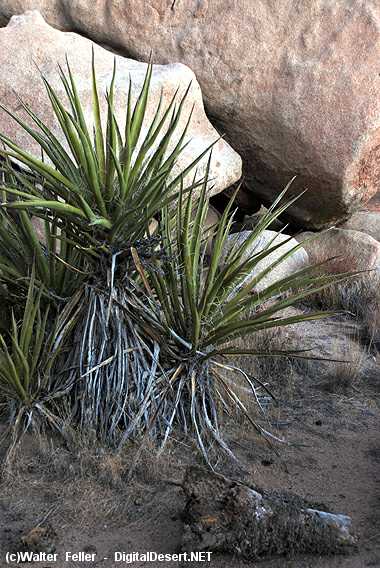
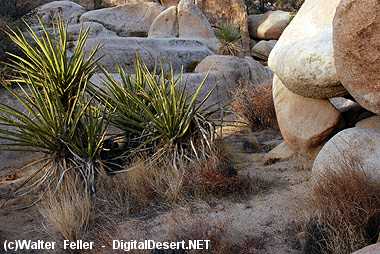
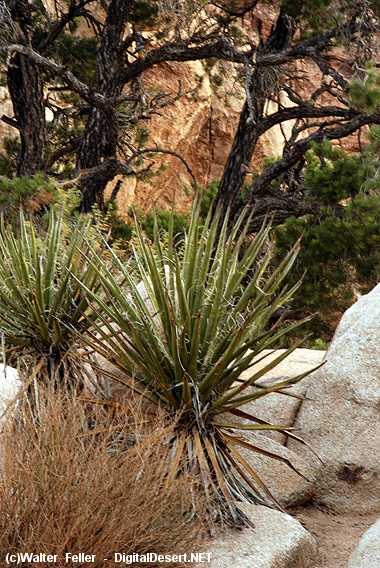
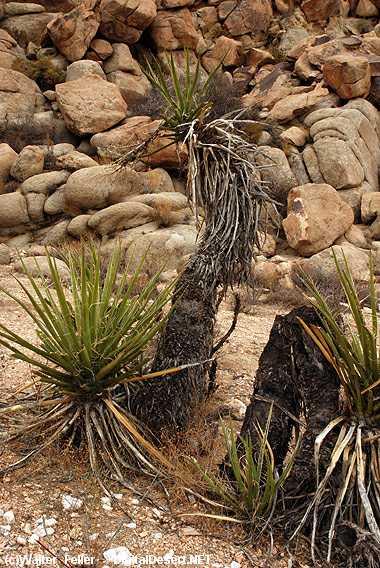
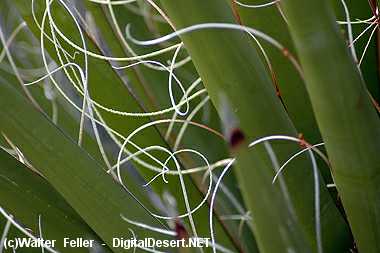
Fibers obtained from the leaves were made into rope, twine, hats, hair brushes, shoes, mattresses, and saddle blankets.

A cactus wren takes refuge in the leaves of a Mojave yucca.